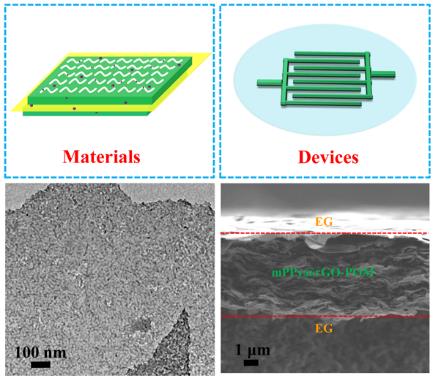
Abstract
Micro-supercapacitors (MSCs) have emerged as one competitive candidate of high-performance, flexible, safe, portable and wearable energy storage devices. However, improving their electrochemical performance from electrode materials to assembled devices still remains huge challenges. Here, we for the first time synthesized a two-dimensional (2D), ultrathin, mesoporous polypyrrole-based graphene nanosheets uniformly anchored with redox polyoxometalate (mPPy@rGO-POM) by soft template approach. Further, using a layer-by-layer deposition and mask-assisted technique, the compactly stacked and sandwich-like hybrid film (mPGM) based on pseudocapacitive mPPy@rGO-POM nanosheets and electrochemically exfoliated graphene was directly fabricated as binder- and additive-free interdigital electrodes for all-solid-state planar micro-supercapacitors (mPGM-MSCs). Notably, the resulting mPGM-MSCs exhibited outstanding areal capacitance (115 mF cm-2), remarkably enhanced volumetric capacitance (137 F cm-3 at 1 mV s-1) in comparison with MSCs based on the films of mPPy@rGO without POM anchoring (95 F cm-3), and non-porous polypyrrole-graphene (68 F cm-3). Further, mPGM-MSCs disclosed robust mechanical flexibility with ~96% of capacitance retention at a highly bending angle of 180 °, and impressive parallel or serial interconnection for boosting capacitance or voltage output. As a consequence, our proposed strategy of filling the redox species into mesoporous graphene and other 2D nanosheets will open up new ways to manufacture high-compact and flexible energy storage devices ranging from supercapacitors to batteries.